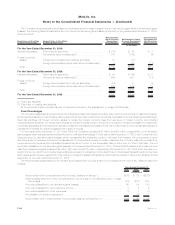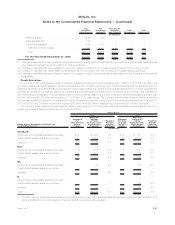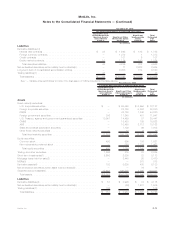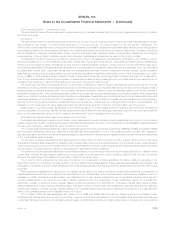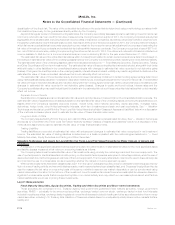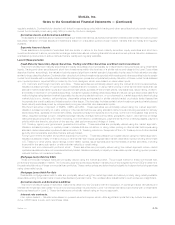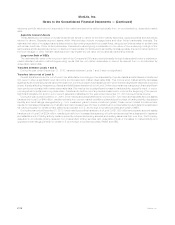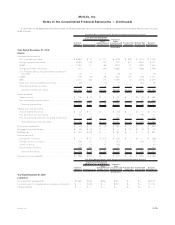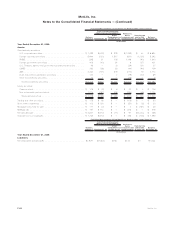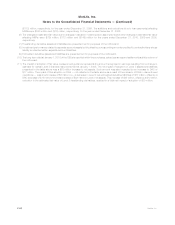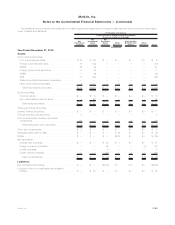MetLife 2010 Annual Report Download - page 162
Download and view the complete annual report
Please find page 162 of the 2010 MetLife annual report below. You can navigate through the pages in the report by either clicking on the pages listed below, or by using the keyword search tool below to find specific information within the annual report.Other Invested Assets — Investment Funds
The estimated fair value of these investment funds is determined on a basis consistent with the methodologies described herein for trading
and other securities.
Derivatives
The estimated fair value of derivatives is determined through the use of quoted market prices for exchange-traded derivatives and interest
rate forwards to sell certain to be announced securities, or through the use of pricing models for over-the-counter derivatives. The
determination of estimated fair value, when quoted market values are not available, is based on market standard valuation methodologies and
inputs that are assumed to be consistent with what other market participants would use when pricing the instruments. Derivative valuations
can be affected by changes in interest rates, foreign currency exchange rates, financial indices, credit spreads, default risk (including the
counterparties to the contract), volatility, liquidity and changes in estimates and assumptions used in the pricing models.
The significant inputs to the pricing models for most over-the-counter derivatives are inputs that are observable in the market or can be
derived principally from or corroborated by observable market data. Significant inputs that are observable generally include: interest rates,
foreign currency exchange rates, interest rate curves, credit curves and volatility. However, certain over-the-counter derivatives may rely on
inputs that are significant to the estimated fair value that are not observable in the market or cannot be derived principally from or corroborated
by observable market data. Significant inputs that are unobservable generally include: independent broker quotes, credit correlation
assumptions, references to emerging market currencies and inputs that are outside the observable portion of the interest rate curve, credit
curve, volatility or other relevant market measure. These unobservable inputs may involve significant management judgment or estimation.
Even though unobservable, these inputs are based on assumptions deemed appropriate given the circumstances and are assumed to be
consistent with what other market participants would use when pricing such instruments.
The credit risk of both the counterparty and the Company are considered in determining the estimated fair value for all over-the-counter
derivatives, and any potential credit adjustment is based on the net exposure by counterparty after taking into account the effects of netting
agreements and collateral arrangements. The Company values its derivative positions using the standard swap curve which includes a
spread to the risk free rate. This credit spread is appropriate for those parties that execute trades at pricing levels consistent with the standard
swap curve. As the Company and its significant derivative counterparties consistently execute trades at such pricing levels, additional credit
risk adjustments are not currently required in the valuation process. The Company’s ability to consistently execute at such pricing levels is in
part due to the netting agreements and collateral arrangements that are in place with all of its significant derivative counterparties. The
evaluation of the requirement to make additional credit risk adjustments is performed by the Company each reporting period.
Most inputs for over-the-counter derivatives are mid market inputs but, in certain cases, bid level inputs are used when they are deemed
more representative of exit value. Market liquidity, as well as the use of different methodologies, assumptions and inputs, may have a material
effect on the estimated fair values of the Company’s derivatives and could materially affect net income.
Embedded Derivatives Within Asset and Liability Host Contracts
Embedded derivatives principally include certain direct, assumed and ceded variable annuity guarantees and equity or bond indexed
crediting rates within certain funding agreements. Embedded derivatives are recorded in the consolidated financial statements at estimated
fair value with changes in estimated fair value reported in net income.
The Company issues certain variable annuity products with guaranteed minimum benefit guarantees. GMWBs, GMABs and certain GMIBs
are embedded derivatives, which are measured at estimated fair value separately from the host variable annuity contract, with changes in
estimated fair value reported in net derivative gains (losses). These embedded derivatives are classified within policyholder account balances
in the consolidated balance sheets.
The fair value of these guarantees is estimated using the present value of future benefits minus the present value of future fees using
actuarial and capital market assumptions related to the projected cash flows over the expected lives of the contracts. A risk neutral valuation
methodology is used under which the cash flows from the guarantees are projected under multiple capital market scenarios using observable
risk free rates, currency exchange rates and observable and estimated implied volatilities.
The valuation of these guarantee liabilities includes adjustments for nonperformance risk and for a risk margin related to non-capital market
inputs. Both of these adjustments are captured as components of the spread which, when combined with the risk free rate, is used to
discount the cash flows of the liability for purposes of determining its fair value.
The nonperformance adjustment is determined by taking into consideration publicly available information relating to spreads in the
secondary market for the Holding Company’s debt, including related credit default swaps. These observable spreads are then adjusted, as
necessary, to reflect the priority of these liabilities and the claims paying ability of the issuing insurance subsidiaries compared to the Holding
Company.
Risk margins are established to capture the non-capital market risks of the instrument which represent the additional compensation a
market participant would require to assume the risks related to the uncertainties of such actuarial assumptions as annuitization, premium
persistency, partial withdrawal and surrenders. The establishment of risk margins requires the use of significant management judgment,
including assumptions of the amount and cost of capital needed to cover the guarantees. These guarantees may be more costly than
expected in volatile or declining equity markets. Market conditions including, but not limited to, changes in interest rates, equity indices,
market volatility and foreign currency exchange rates; changes in nonperformance risk; and variations in actuarial assumptions regarding
policyholder behavior, mortality and risk margins related to non-capital market inputs may result in significant fluctuations in the estimated fair
value of the guarantees that could materially affect net income.
The Company ceded the risk associated with certain of the GMIB and GMAB described above. These reinsurance contracts contain
embedded derivatives which are included in premiums, reinsurance and other receivables in the consolidated balance sheets with changes
in estimated fair value reported in net derivative gains (losses) or policyholder benefits and claims depending on the statement of operations
F-73MetLife, Inc.
MetLife, Inc.
Notes to the Consolidated Financial Statements — (Continued)



